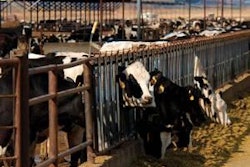Measurement of cross-contamination that can occur in feed plants is a very serious issue throughout feed industries worldwide. However, the general goal to "reduce cross-contamination" has no real meaning in the feed plant unless it is defined and supplemented with tangible, quantifiable objectives. A three-year European Union project offers a summation of progress, with results recently presented at the Tecaliman meeting at Nantes, France.
Five years ago, in line with the on-going effort to co-ordinate and harmonize EU feed and food safety controls across the now-25 member states, Tecaliman researchers, including Fabrice Putier who became director of Tecaliman last year, conceived a unique research project. The project would meet the requirements of European legislation Directive 95/69/EC for the evaluation of homogeneity and cross-contamination in feed mixes: "There must be sufficient and appropriate means for carrying out checks during the course of manufacture" so as to "guarantee and check the homogeneity of the additives in the premixtures or in the compound feeding stuffs, and as low a level of cross-contamination as possible."
Homogeneity and cross-contamination
'Homogeneity' was defined as 'dispersion around the mean' (or average) and 'cross-contamination' was defined as 'carry-over of an additive between following batches of feed'.
Homogeneity and cross-contamination are linked as concepts but serve very different purposes in evaluation of feed quality and safety. For example, a feed mixture may present a large number of fine particles or fewer large particles to meet the requirement of the formulation. Generally, there is better homogeneity of the mixture--lower co-efficient of variation (CV) given the mixing of finer particles. However, finer particles also present a greater risk of cross-contamination, the tendency of particles to remain in the mixer or other equipment following discharge of the batch. These particles then may contaminate subsequent batches.
A simple solution for ending the risk of cross-contamination of, for example, an antibiotic compound may be to halt inclusion of the compound in the formula and the feed plant. This can bring cross-contamination of that ingredient to an end, but is not likely to affect the homogeneity of the feed mixture.
As a practical matter, a mixing co-efficient of variation of 5% seems realistic at the mixer, but it cannot be the basis of regulation, as no scientific studies show that more than 5 percent is dangerous either for animal or for human consumption. Performance in the range of 5-10% CV seems like the right target to most feed scientists.
Table 1: Mixing performance in French feed plants; Table 2: Yttrium tracer performance
Search for ideal tracer
Mr. Putier and Tecaliman researchers quickly established that one of the main limiting factors in the standardization and harmonization of feed testing for homogeneity and cross-contamination was the mix testing protocol itself. The particular challenge was the choice of tracer to be added to feeds to quantify both the quality of mix and the amount of cross-contamination in subsequent feed batches. As Dr Delphine Salvat-Brunaud of Eurofins explained in a recent Tecaliman workshop in Nantes, during the institute's celebration of its 25th anniversary: None of the available mixer testing and cross-contamination quantification methods provided complete satisfaction as a practical, universal technique (see box 'Cross Conta's ideal tracer').
The Tecaliman team realized that standardized tracer and mix testing protocols could benefit feed manufacturers and regulators across Europe. Tecaliman subsequently embarked on a collaborative research project involving the DIL research institute in Germany, premix maker Vitamix in Belgium and feed compounder Petrini in Italy, and feed laboratories including INETI in Portugal and Eurofins in France. Thus the Cross Conta project was born and has since taken into account the EU's new feed hygiene regulation. Its goal over the past three years has been to determine the best material for use as a tracer in feed mixer testing and product cross-contamination checks.
Dr Salvat-Brunaud explained in Nantes that the first step of the Cross Conta project was to narrow the range of possible tracers, which involved first collecting available information about tracers, methods of their application and testing, and their limitations in feed applications, including potential toxicity. There were both external' tracers--to be added as inert components to the feed--and 'internal' tracers--which were integral components of the feed formulation. The range of external tracers used in Europe was quite broad, including colored iron particles or 'microtracer' (used in France, from Micro-Tracers, Inc), methylviolet (used in Germany), and cobalt (as cobalt carbonate, used in Belgium). The internal tracers used in Europe included antibiotics (such as oxytetracycline) or other medicinal compounds. By contrast, simple table salt (sodium chloride) has been one of the traditional tracers for use in mixer trials, but has been superseded in Europe by more reliably accurate compounds.
Screening candidate tracers
Following an initial screening from the science literature, the Cross Conta investigators focused on a number of potential tracer compounds for an evaluation of toxicity, analytical feasibility, and cost. This step resulted in rejection of about 15 tracer candidates as diverse as synthetic aromas, radio-tracers, polyethelene-glycol, fluoresceine, trehalose, irradiate egg shell, chromium oxide, and others. Subsequently, five new tracers were selected for laboratory trials--titanium, yttrium, ytterbium, gadolinium, and a fixed fatty acid blendalong-- with the four tracers already in use in the EU.
Initial lab trials focused on analytical methods to determine 'mixability' or dispersion in sample feed mixtures supplemented with increasing concentrations of tracers. This step further screened the tracer candidates to seven tracers which went on for pilot and industrial-scale trials: Microtracer, methylviolet, cobalt, oxytetracyclin, yttrium, ytterbium, and titanium.
Subsequent lab trials demonstrated the effect of the number of particles on the analytical variation of the tracers, with good recovery of the microtracer after steam application. In these trials, methylviolet showed its sensitivity to steam. However, both proved sensitive to pelleting (70% microtracer recovery versus 50% for methylviolet), which complicated the analysis of cross-contamination after the granulation.
Next the Cross Conta investigators conducted pilot plant trials with the candidate tracers in complete or compound feeds. Protocols differed somewhat, as between Tecaliman in France and DIL in Germany. However, as Dr Ing H-D Jansen explained, those trials showed a good mixing result for all tracers. Even if the recovery of each tracer differed, all tracers, both those in established use and newly proposed--were able to be measured at the carry-over rate at pilot plant scale. The investigators noted that the tracer concentrations necessary to detect cross-contamination differed and the carry-over rates differed, probably because of different physical properties of the tracers. The candidate tracers also were tested in premix trials, which demonstrated that it is much more difficult to find a good tracer for premixes than for complete feed. Katrien Deschepper of Vitamex explained that the existing tracers were much more predictable than the new tracers in homogeneity trials. Yttrium and ytterbium gave good results in cross-contamination trials, but their recovery levels were too low. Another factor that became increasingly apparent: The new tracers were significantly more expensive than the old ones.
'Still work to do'
"There is still work to do," Ms Deschepper concluded, a comment Mr. Putier of Tecaliman quickly confirmed.
He then described validation trials of the final selection of Cross Conta tracer candidates in feed factories--eight in France, seven in Germany, and six in Italy. These trials compared performance of three ‘new' tracers plus oxytetracycline (as it is used widely in feed plant tests) and the three old tracers60 trials in all.
These trials concluded with good results for the microtracer before pelleting, which showed its advantage over yttrium and ytterbium. They also showed the necessity to adjust the incorporation of yttrium at 200 ppm, while revealing the high cost of the pure products in practical feed manufacturing operations.
Micro-Tracers' president David Eisenberg, who attended the Nantes meeting, noted that all EU feed regulatory and research authorities consider the USA American Society of Agricultural Engineers (ASAE) mix testing method using sodium chloride at 2% as an inadequate tracer for feed homogeneity analysis: "How can you say a drug added at 1 part per million (such as an anticoccidial) is properly mixed based on salt as a tracer added at 20,000 ppm?"
Mr. Eisenberg told Feed International that the particle count method for validating mixing and cross-contamination control procedures using microtracers is in the process of receiving GMP+ approval for use throughout the EU.
The Cross Conta investigators at Nantes concluded that internal tracers offer a number of advantages in homogeneity and cross-contamination evaluation within the feed plant. If non-antibiotic ingredients are used, for example, synthetic methionine and lysine, then homogeneity and cross-contamination evaluations are not limited to medicated feeds (such as would contain contrary to oxytetraclycin). However, the investigators also concluded that comparisons of homogeneity and cross-contamination performance between plants still demanded the use of the same tracer. They pointed out that the microtracer remained the best compromise at present.

.jpg?auto=format%2Ccompress&fit=crop&h=167&q=70&w=250)













